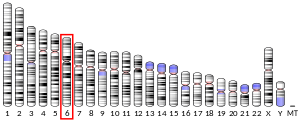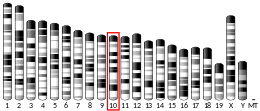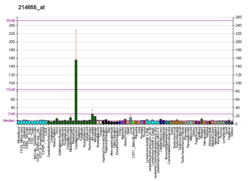GPR6
GPR6
Protein-coding gene in the species Homo sapiens
G protein-coupled receptor 6, also known as GPR6, is a protein which in humans is encoded by the GPR6 gene.[5][6]
Quick Facts Identifiers, Aliases ...
| GPR6 | |||||||||||||||||||||||||||||||||||||||||||||||||||
|---|---|---|---|---|---|---|---|---|---|---|---|---|---|---|---|---|---|---|---|---|---|---|---|---|---|---|---|---|---|---|---|---|---|---|---|---|---|---|---|---|---|---|---|---|---|---|---|---|---|---|---|
| Identifiers | |||||||||||||||||||||||||||||||||||||||||||||||||||
| Aliases | GPR6, G protein-coupled receptor 6 | ||||||||||||||||||||||||||||||||||||||||||||||||||
| External IDs | OMIM: 600553; MGI: 2155249; HomoloGene: 38026; GeneCards: GPR6; OMA:GPR6 - orthologs | ||||||||||||||||||||||||||||||||||||||||||||||||||
| |||||||||||||||||||||||||||||||||||||||||||||||||||
| |||||||||||||||||||||||||||||||||||||||||||||||||||
| |||||||||||||||||||||||||||||||||||||||||||||||||||
| |||||||||||||||||||||||||||||||||||||||||||||||||||
| |||||||||||||||||||||||||||||||||||||||||||||||||||
| Wikidata | |||||||||||||||||||||||||||||||||||||||||||||||||||
| |||||||||||||||||||||||||||||||||||||||||||||||||||
Close
GPR6 is a member of the G protein-coupled receptor family of transmembrane receptors. It has been reported that GPR6 is both constitutively active but in addition is further activated by sphingosine-1-phosphate.[7]
GPR6 up-regulates cyclic AMP levels and promotes neurite outgrowth.[8]
Inverse Agonist
Paralogues to GPR6 gene
Source:[10]
- "Human PubMed Reference:". National Center for Biotechnology Information, U.S. National Library of Medicine.
- "Mouse PubMed Reference:". National Center for Biotechnology Information, U.S. National Library of Medicine.
- Song ZH, Modi W, Bonner TI (July 1995). "Molecular cloning and chromosomal localization of human genes encoding three closely related G protein-coupled receptors". Genomics. 28 (2): 347–349. doi:10.1006/geno.1995.1154. PMID 8530049.
- Uhlenbrock K, Gassenhuber H, Kostenis E (November 2002). "Sphingosine 1-phosphate is a ligand of the human gpr3, gpr6 and gpr12 family of constitutively active G protein-coupled receptors". Cellular Signalling. 14 (11): 941–953. doi:10.1016/S0898-6568(02)00041-4. PMID 12220620.
- Tanaka S, Ishii K, Kasai K, Yoon SO, Saeki Y (April 2007). "Neural expression of G protein-coupled receptors GPR3, GPR6, and GPR12 up-regulates cyclic AMP levels and promotes neurite outgrowth". The Journal of Biological Chemistry. 282 (14): 10506–10515. doi:10.1074/jbc.M700911200. PMID 17284443.
- Laun AS, Shrader SH, Brown KJ, Song ZH (March 2019). "GPR3, GPR6, and GPR12 as novel molecular targets: their biological functions and interaction with cannabidiol". Acta Pharmacologica Sinica. 40 (3): 300–308. doi:10.1038/s41401-018-0031-9. PMC 6460361. PMID 29941868.
- Heiber M, Docherty JM, Shah G, Nguyen T, Cheng R, Heng HH, et al. (January 1995). "Isolation of three novel human genes encoding G protein-coupled receptors". DNA and Cell Biology. 14 (1): 25–35. doi:10.1089/dna.1995.14.25. PMID 7832990.
- Song ZH, Modi W, Bonner TI (July 1995). "Molecular cloning and chromosomal localization of human genes encoding three closely related G protein-coupled receptors". Genomics. 28 (2): 347–349. doi:10.1006/geno.1995.1154. PMID 8530049.
- Uhlenbrock K, Huber J, Ardati A, Busch AE, Kostenis E (2003). "Fluid shear stress differentially regulates gpr3, gpr6, and gpr12 expression in human umbilical vein endothelial cells". Cellular Physiology and Biochemistry. 13 (2): 75–84. doi:10.1159/000070251. PMID 12649592. S2CID 45156405.
- "GPR6". IUPHAR Database of Receptors and Ion Channels. International Union of Basic and Clinical Pharmacology. Archived from the original on 2012-09-02. Retrieved 2009-04-24.
This transmembrane receptor-related article is a stub. You can help Wikipedia by expanding it. |




